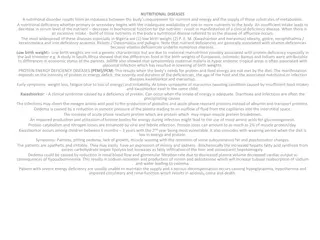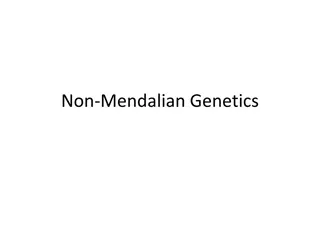Understanding X-Linked Inheritance and Diseases
X-linked inheritance involves genes on the X chromosome, leading to unique inheritance patterns and characteristics. X-linked diseases vary in expression between males and females due to differences in chromosome composition. X-linked dominant traits are rare but can have significant impacts on affected individuals. Alport Syndrome is an example of an X-linked dominant disease characterized by kidney inflammation.
Uploaded on Sep 13, 2024 | 1 Views
Download Presentation

Please find below an Image/Link to download the presentation.
The content on the website is provided AS IS for your information and personal use only. It may not be sold, licensed, or shared on other websites without obtaining consent from the author. Download presentation by click this link. If you encounter any issues during the download, it is possible that the publisher has removed the file from their server.
E N D
Presentation Transcript
A human female, has 23 pair of chromosomes A human male, has 22 similar pairs and one pair consisting of two chromosomes that are dissimilar in size and structure. The 23 rd pair in both the sexes is calledsex chromosomes Female, XX. the male, XY
X-linked diseases X-linked diseases are those for which the gene is present on the X chromosome. X-linked diseases show inheritance patterns that differ from autosomal diseases. This occurs because males only have one copy of the X chromosome (plus their Y chromosome) and females have two X chromosomes. Because of this, males and females show different patterns of inheritance and severity of manifestation.
While there are both dominant and recessive X-linked diseases, there are some characteristics that are common to X-linked disorders in general X-linked genes are never passed from father to son. The Y chromosome is the only sex chromosome that passes from father to son. Males are never carriers if they have a mutated gene on the X chromosome, it will be expressed. Males are termed hemizygous for genes on the X chromosome.
X-linked dominant Traits hereditary pattern in which a dominant gene on the X chromosome causes a characteristic to be manifested in the offspring. X-linked dominant diseases are those that are expressed in females when only a single copy of the mutated gene is present. Very few X-linked dominant diseases have been identified (e.g. hypophosphatemic rickets, Alport syndrome, diabetes insipidus)
Characteristics of X-linked dominant diseases Never passed from father to son. Affected males produce only affected females. An affected male only has one X chromosome to pass on to his daughters Affected females produce 50% normal and 50% affected offspring.. heterozygous >>>> Males are usually more severely affected than females. Some X-linked dominant traits may even be lethal to males. Females are more likely to be affected. Since females have 2 X chromosomes, they have 2 chances to inherit the mutated allele.
Alport Syndrome Alport syndrome or hereditary nephritis is a genetic disorder characterized by glomerulonephritis (also known as glomerular nephritis (GN), is a renal disease (usually of both kidneys) characterized by inflammation of the glomeruli (In Kidneys, a tubular structure called nephron filters blood to form urine. At the beginning of the nephron, the glomerulus is a network (tuft) of capillaries that performs the first step of filtering blood) or small blood vessels in the kidneys.
It may present with isolated hematuria and/or proteinuria (blood or protein in urine); or as a nephrotic syndrome, acute or chronic renal failure), End-stage kidney disease, and hearing loss. Alport syndrome can also affect the eyes (lenticonus). It was first identified in a British family by Dr. Cecil A. Alport in 1927, though William Howship Dickinson is considered by some to have made contributions to the characterization.
Causes of Alport Syndrome Alport syndrome is caused by mutations in COL4A3, COL4A4 and COL4A5 collagen biosynthesis genes. Mutations in any of these genes prevent the proper production or assembly of the type IV collagen network, which is an important structural component of basement membranes in the kidney, inner ear and eye. Basement membranes are thin, sheet-like structures that separate and support cells in many tissues.
When mutations prevent the formation of type IV collagen fibers, the basement membranes of the kidneys are not able to filter waste products from the blood and create urine normally, allowing blood and protein into the urine. The abnormalities of type IV collagen in kidney basement membranes cause gradual scarring of the kidneys, eventually leading to kidney failure in many people with the disease.
Inheritance patterns In most people with Alport syndrome, the condition is inherited in an X-linked dominant pattern, due to mutations in the COL4A5 gene. In males, who have only one X chromosome, one altered copy of the COL4A5 gene is sufficient to cause severe Alport syndrome, explaining why most affected males eventually develop kidney failure.
In females, who have two X chromosomes, a mutation in one copy of the COL4A5 gene usually results in blood in the urine, but most affected females do not develop kidney failure. Alport syndrome can be inherited in an autosomal recessive pattern if both copies of the COL4A3 or COL4A4 gene, located on chromosome 2 have been mutated.
Treatment As there is no known cure, treatments are symptomatic. Patients are advised on how to manage the complications of kidney failure and the proteinuria that develops is often treated with ACE inhibitors. Once kidney failure has developed, patients are given dialysis or can benefit from a kidney transplant, although this can cause problems. The body may reject the new kidney as it contains normal type IV collagen, which may be recognized as foreign by the immune system. Gene therapy as a possible treatment option has been discussed.
X-linked recessiveTraits hereditary pattern in which a recessive gene on the X chromosome results in the manifestation of characteristics in male offspring and a carrier state in female offspring X-linked recessive diseases are those in which a female must have two copies of the mutant allele in order for the mutant phenotype to develop. Many X-linked recessive disorders are well-known, including color blindness, hemophilia, and Duchenne muscular dystrophy.
All males possessing an X-linked recessive mutation will be affected (males have a single X-chromosome and therefore have only one copy of X-linked genes). All offspring of a carrier female have a 50% chance of inheriting the mutation. All female children of an affected father will be carriers (daughters possess their fathers' X-chromosome). No male children of an affected father will be affected (sons do not inherit their fathers' X-chromosome).
Hemophilia Hemophilia (from the Greek haima 'blood' and philia 'love') is a group of heredity genetic disorders that impair the body's ability to control blood clotting or coagulation, which is used to stop bleeding when a blood vessel is broken. Hemophilia A (clotting factor VIII deficiency) is the most common form of the disorder, present in about 1 in 5,000 10,000 male births. Hemophilia B (factor IX deficiency) occurs in around 1 in about 20,000 34,000 male births.
Physiology The gene for factor VIII is located on the X-chromosome (Xq28). In the blood, it mainly circulates in a stable noncovalent complex with Von Willi-brand factor. Upon activation by thrombin, (factor IIa), it dissociates from the complex to interact with factor IXa in the coagulation cascade. It is a cofactor to factor IXa in the activation of factor X, which, in turn, with its cofactor, factor Va, activates more thrombin. Thrombin cleaves fibrinogen into fibrin which polymerizes and crosslinks (using factor XIII) into a blood clot.
Like most recessive X-linked disorders, hemophilia is more likely to occur in males than females. This is because females have two X chromosomes while males have only one, so the defective gene is guaranteed to manifest in any male who carries it. Because females have two X chromosomes and haemophilia is rare, the chance of a female having two defective copies of the gene is very remote, so females are almost exclusively asymptomatic carriers of the disorder. Female carriers can inherit the defective gene from either their mother or father, or it may be a new mutation.
Although it is not impossible for a female to have haemophilia, it is unusual: a female with haemophilia A or B would have to be the daughter of both a male hemophiliac and a female carrier, while the non-sex-linked haemophilia C due to coagulant factor XI deficiency, which can affect either sex, is more common in Jews of Ashkenazi (East European) descent but rare in other population groups.
Hemophilia lowers blood plasma clotting factor levels of the coagulation factors needed for a normal clotting process. Thus, when a blood vessel is injured, a temporary scab does form, but the missing coagulation factors prevent fibrin formation, which is necessary to maintain the blood clot. A hemophiliac does not bleed more intensely than a person without it, but can bleed for a much longer time. In severe hemophiliacs, even a minor injury can result in blood loss lasting days or weeks, or even never healing completely. In areas, such as the brain or inside joints, this can be fatal or permanently debilitating.
Types of Haemophilia Haemophilia A is a recessive X-linked genetic disorder involving a lack of functional clotting Factor VIII and represents 80% of haemophilia cases. Haemophilia B is a recessive X-linked genetic disorder involving a lack of functional clotting Factor IX and comprises about 20% of hemophilia cases. Haemophilia C is an autosomal genetic disorder (i.e. not X-linked) involving a lack of functional clotting Factor XI. Haemophilia C is not completely recessive, as heterozygous individuals also show increased bleeding.























